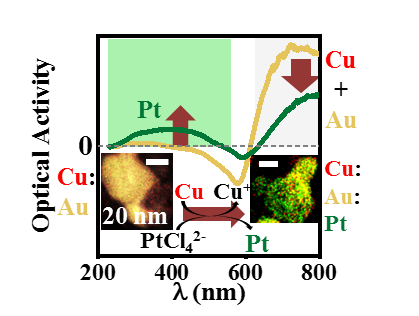Dr HUANG Zhifeng led a collaboration team to devise a facile method to fabricate three-element (or ternary) CNPs by combining galvanic replacement reactions (GRRs) with a three-step layer-by-layer GLAD (LbL-GLAD)
Chirality, an asymmetric property denoting an object to be non-superimposable on its mirror image, is a natural phenomenon. Especially in bio-systems, biomolecules naturally occur in only one of two stereoisomeric configurations, meaning the homochirality. It has been of fundamental interest to impose structural chirality onto inorganic nanomaterials under diverse chiral forces, resulting in novel asymmetric properties that have enabled the fast development of important applications in the fields of light polarization, chiral sensing, refractive index sensing, nanorheological measurement, drug delivery, and bio-applications.
Among the diverse approaches developed to generate chiral nanostructures, glancing angle deposition (GLAD) shows the superior features in one-step generation, production scalability, and device fabrication compatibility. In the GLAD with fast substrate rotation (GLAD-FSR), macroscopic shear forces are applied by substrate rotation along with the translation of incident atoms, to produce chiral nanoparticles (CNPs) inherently consisting of atomically chiral lattices, including an excess of the twinning lattices, chiral defects in grain boundaries, and the wavelike chiral lattices. The chiral lattices make the CNPs chiroptically active and cause the enantiospecific adsorption of chiral molecules on the CNPs, leading to the remarked amplification of molecular optical activity and the enantioselective photo-induced cyclodimerization of prochiral molecules.
CNPs mainly consist of mono-elemental (or unary) metals. Multi-elemental (more than three elements) achiral nanoparticles have been fabricated to show remarkedly superior features in catalytic activity, selectivity and stability compared to the unary counterparts, due to the multielement-induced synergistic effect. It paves the way towards the functionality enhancement in the chirality-related applications of enantio-differentiation (differentiation of a chiral molecule or enantiomer from its mirror image), enantio-separation (separation of an enantiomer from its mirror image), bio-imaging, bio-detection, drug delivery, and single-enantiomer pharmaceutical production. Diverse methods, having been developed to fabricate multi-elemental achiral nanoparticles, usually involve high-temperature or high-energy alloying, which will inevitably lead to the degradation of the chiral lattices that are thermodynamically metastable to achiral lattices. Therefore, it is very challenging but of fundamental significance to produce multi-elemental CNPs.
Recently, Dr. Zhifeng HUANG, Associate Professor in Department of Physics at HKBU, led a collaboration team (with Dr. Meng GU, Southern University of Science and Technology, Shenzhen) to devise a facile method to fabricate three-element (or ternary) CNPs by combining galvanic replacement reactions (GRRs) with a three-step layer-by-layer GLAD (LbL-GLAD). This collaboration work was published in the renown journal Advanced Science (Adv. Sci. 2020, 2001321; https://doi.org/10.1002/advs.202001321).
The generation process of the ternary CNPs is composed of two steps. First of all, LbL-GLAD (which is similar to make ‘sandwiches’, two ‘bread’ of one metal CNPs, and another metal function as ‘cheese’) was operated to fabricate binary CNPs. The binary CNPs, functioning as the chiral sacrificing template, were then treated with GRRs to add the third metal onto CNPs, leading to the formation of the ternary CNPs. This is a facile approach generally adapted to the production of ternary CNPs composed of diverse metals, paving the way towards diverse public health-related applications in enantio-differentiation, enantio-separation, asymmetric catalysis, disease diagnosis, and drug production.


